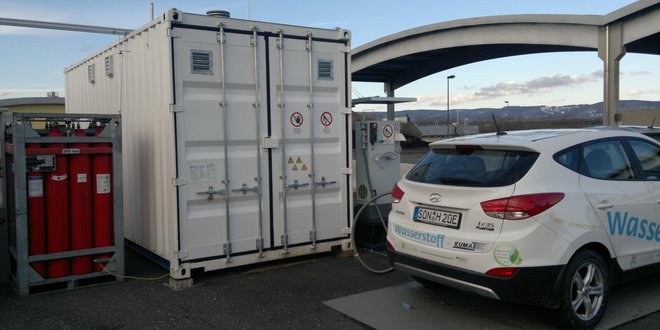
Distributed Water Electrolysis System Research

Project title:
HYPOS LocalHy - Distributed electrolysis system with combined hydrogen and oxygen usage from renewables
Subproject:
System design and assessment of using oxygen from water electrolysis in municipal sewage works
Funding body:
Federal Ministry of Education and Research (BMBF)
Project duration:
01.08.2015 - 31.10.2020
Principal investigator of the subproject:
Prof. Dr. Mark Jentsch
Project partners:
AVX/Kumatec Hydrogen GmbH & Co. KG, isle Steuerungstechnik und Leistungselektronik GmbH, sera ComPress GmbH, WTZ Roßlau gGmbH, Wasserwerke Sonneberg, Fraunhofer-Center für Silizium-Photovoltaik CSP
Team members involved in the project:
Dipl. UWT Sebastian Büttner, Nicole Meyer M.Sc.
Project Website:
→ www.localhy.de
Project Outline
The collaborative research and development project LocalHy with 7 partners from industry and academia forms part of the initiative Zwanzig20 - HYPOS Hydrogen Power Storage & Solutions East Germany funded by the Federal Ministry of Education and Research (BMBF). It aims at developing a distributed electrolysis system for decentralized hydrogen production and use to be installed on a municipal sewage work. This is highlighted in Figure 1.
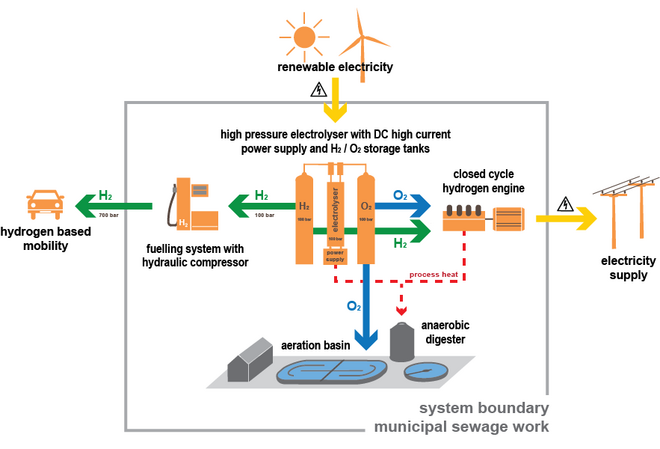
The core component of the LocalHy system is a pressure electrolyser at 100 bar, which is used for the production of hydrogen and oxygen from renewable electricity. This system is complemented by a novel hydrogen fuelling station for fuel cell vehicles and a newly developed closed cycle hydrogen-oxygen engine for electricity generation. The subproject of the Bauhaus-Universität Weimar is looking at using the “waste product” oxygen from the electrolysis in the aeration basins of municipal sewage works in order to substitute aeration fans. For this purpose the test facility shown in Figure 2a has been developed for looking at optimising the oxygen distribution in water. Furthermore, as demonstrated by Figures 2b to 4 a scaled experimental sewage treatment plant has been constructed. This plant consists of two streets with aeration basin and final sedimentation for 100 residents each in order to investigate oxygen aeration in comparison to conventional operation with aeration fans. Further to this the subproject is looking into the potentials of using wastewater treatment plants equipped with electrolysers for power range control in an electricity grid increasingly relying on renewable energy.
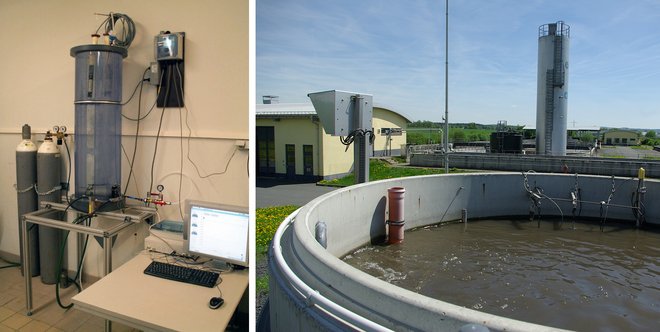
The entire system is being brought together, installed, operated and evaluated as a demonstrator at the Sonneberg-Heubisch wastewater treatment plant in Southern Thuringia.
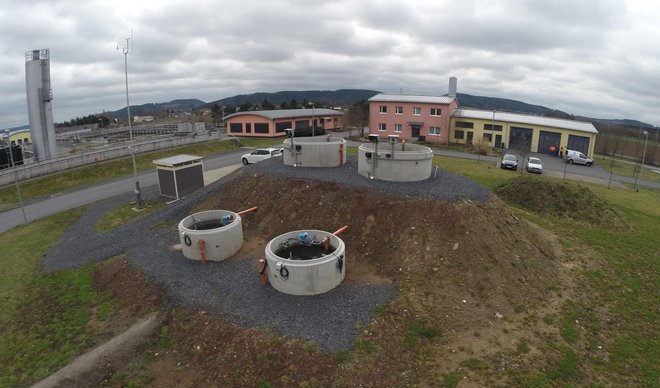
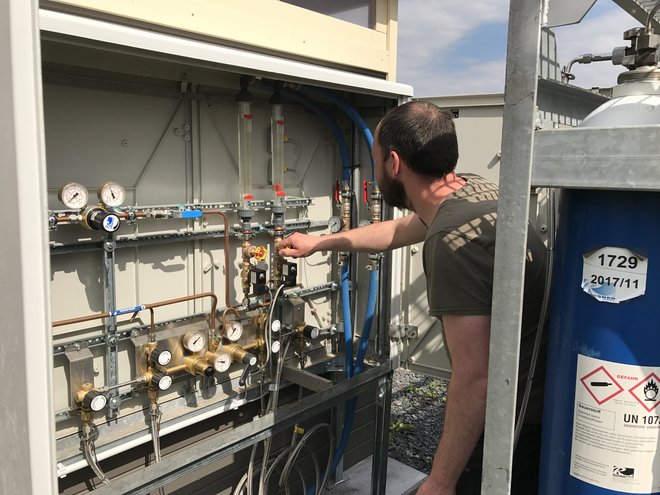
Potential Benefits of the System
There are a range of potential benefits of the LocalHy system in a future energy system. These are as follows:
(a) Municipal wastewater treatment plants are distributed over the entire country in relation to the number of inhabitants. ⇒ The size of sewage works corresponds to the local supply and demand of electricity (electrolyser sizing / electricity generation from hydrogen), oxygen (biological treatment stage of the sewage work / closed cycle hydrogen-oxygen engine) and mobility (hydrogen fuelling station).
(b) A system consisting of an electrolyser and a hydrogen engine installed on wastewater treatment plants allows for a local electricity grid stabilization by providing options for positive (electrolyser) and negative power range control (closed cycle hydrogen-oxygen engine). ⇒ Effective use of renewable electricity in times of low demand / important contribution to a more sustainable electricity supply system.
(c) There is no need for installing a new power infrastructure as the system can be integrated locally into existing grid infrastructures.
(d) It is possible to develop a distributed supply infrastructure for supplying fuelling stations with hydrogen. ⇒ Added value is created in the local community, enabling consumption of locally sourced hydrogen. There is no need for transporting commodities over large distances.
(e) Effective sector coupling is being achieved in urban areas across the sectors of wastewater management, electricity supply and mobility.
Innovation
The LocalHy system is the world's first power-to-gas system that simultaneously addresses the challenges of improving energy efficiency and reducing emissions at a decentralized scale in order to deliver solutions for the energy industry, mobility and municipal wastewater treatment. Furthermore, it needs to be emphasized that the approach of a distributed system also enables local value creation and, in addition to effective environmental, water and climate protection, also promotes sustainable development at local level.
Conducted Work and results
Various experiments conducted in the scaled experimental sewage plant will allow for assessing the required amount of pure oxygen for an effective wastewater treatment as well as for determining the necessary system configurations. These experiments are currently underway and, as demonstrated by Figures 5 and 6, the results on the treatment performance are looking promising. The overarching aim of these first experiments was to prove that the oxygen delivered by the electrolysis of water can be used in conventional sewage works with limited adaptation requirements, whilst at the same time retaining or even improving the sewage treatment capacity. The general feasibility has been proven during several months of operation of the plant in 2017 and 2018.
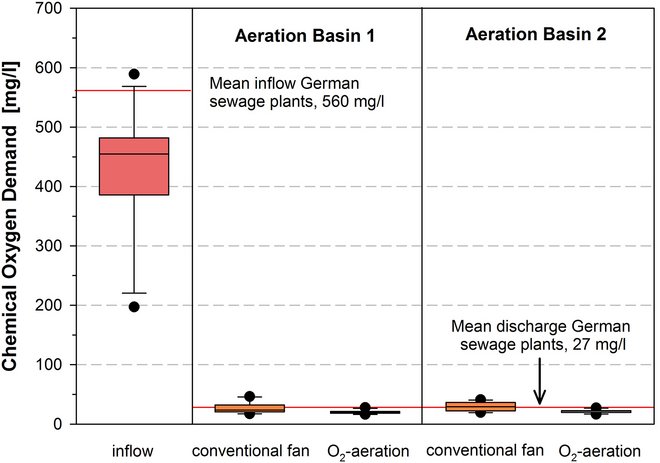
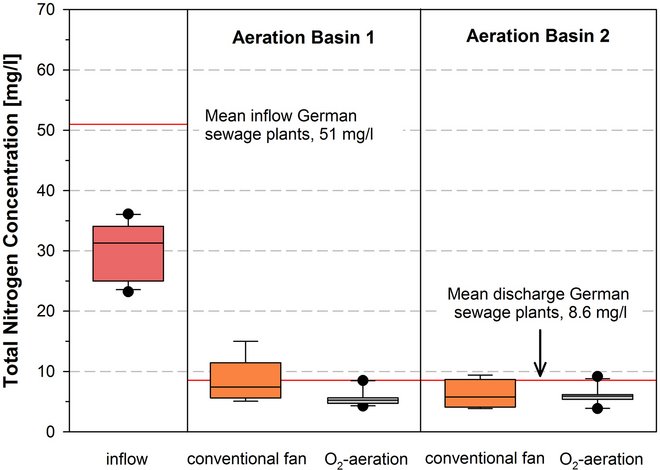
The experiments that are being conducted throughout 2019 seek to develop an optimised operation regime for using pure oxygen from water electrolysis. Coupled with a bespoke simulation model for the electrolysis system the waste water treatment and energy performance data will finally permit deriving clear indications for upscaling the plant as well as the economic viability of the system. This will then permit to develop recommendations for the operation and implementation of water electrolysis systems on sewage treatment plants.
Published work
Büttner S, Jentsch MF, Hörnlein S, Hubner B. Sektorenkopplung im Rahmen der Energiewende – Einsatz von Elektrolysesauerstoff auf kommunalen Kläranlagen, Proceedings 25. Symposium Nutzung Regenerativer Energiequellen und Wasserstofftechnik, Stralsund, 07-10 November 2018, 22-41. → view paper
Jentsch MF, Büttner S. Dezentrale Umsetzung der Energie- und Verkehrswende mit Wasserstoffsystemen auf Kläranlagen, gwf Gas + Energie, 160 (6) (2019) 28-39. → view paper
